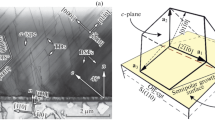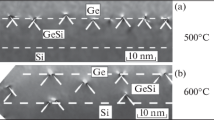Abstract
The potential for interactions of misfit strain relieving dislocations with inversion-type antiphase domain boundaries is considered for III–V on group IV growth. The specific cases of GaAs grown on Si (001) and vicinal (001) substrates are examined. It is shown that threading dislocation densities for these growths should be unacceptably high due to obstruction of threading dislocation motion by the antiphase domain boundaries, even when the boundaries are eliminated shortly after the inception of GaAs layer growth. Cutting of the antiphase domain boundaries by mobile dislocations would require creation of new highenergy surface area. It is suggested that more successful routes would be growth of a strain-relieving buffer or growth on a {hhk} surface.
Similar content being viewed by others
References
A. Georgakilas, J. Stoemenos, K. Tsagaraki, Ph. Komninou, N. Flevaris, P. Panayotatos and A. Christous,J. Mater. Res. 8 (8), 1908 (1993).
S.I. Molina, G. Aragón, R. García, Y. Gonzáles, L. Gonzáles and F. Briones,J. Electron. Mater. 22 (5), 567 (1993).
M.M. Al-Jassim, T. Nishioka, Y. Itoh, A. Yamamoto and M. Yamaguchi,MRS Symp. Proc 116, 141 (1988).
H.L. Tsai and J.W. Lee,Appl. Phys. Lett. 51, 130 (1988).
Z. Lilienthal-Weber,MRS Symp. Proc. 148, 205 (1989).
M. Yamaguchi, A. Yamamoto, M. Tachikawa, Y. Itoh and M. Suga,Appl. Phys. Lett. 53, 2293 (1988).
S. L. Wright and H. Kroemer,Appl. Phys. Lett. 37, 210 (1980).
R. Hull, J.C. Bean, R.E. Leibenguth and D.J. Werder,J. Appl. Phys. 65, 4723 (1989).
W.Q. Li, P.K. Bhattacharya, S.H. Kwok and R. Merlin,J. Appl. Phys. 72 (7), 3129 (1992).
E.A. Fitzgerald,JOM 41, 20 (1989).
L.B. Freund,J. Appl. Phys. 68, 2073 (1990).
E.P. Kvam, D.M. Maher and C.J. Humphreys,J. Mater. Res. 5, 1900 (1990).
E.P. Kwam and F. Namavar,Appl. Phys. Lett. 58 (21), 2357 (1991).
E.P. Kvam,Phil. Mag. Lett. 62, 167 (1990).
O.L. Alerhand, A.N. Berker, J.D. Joannopoulos, D. Vanderbilt, R.J. Hamers and J.E. DemuthPhys. Rev. Lett. 64, 2406 (1990).
J.J. deMiguel, C.E. Aumann, R. Kariotis and M.G. Lagally,Phys. Rev. Lett. 67, 2830 (1991).
D. Vanderbilt and C. Lee,Phys. Rev. B 45(19), 11192 (1992).
R. Hull and J.C. Bean,Critical Reviews in Solid State and Materials Science 17(6), 507 (1992).
Author information
Authors and Affiliations
Rights and permissions
About this article
Cite this article
Kvam, E.P. Interactions of dislocations and antiphase (inversion) domain boundaries in III–V/IV heteroepitaxy. J. Electron. Mater. 23, 1021–1026 (1994). https://doi.org/10.1007/BF02650370
Received:
Revised:
Issue Date:
DOI: https://doi.org/10.1007/BF02650370




